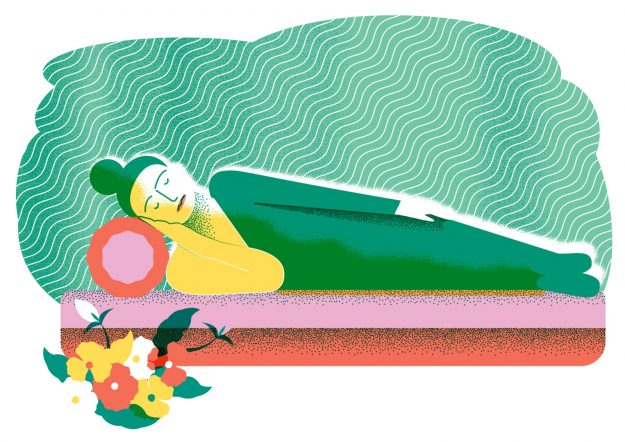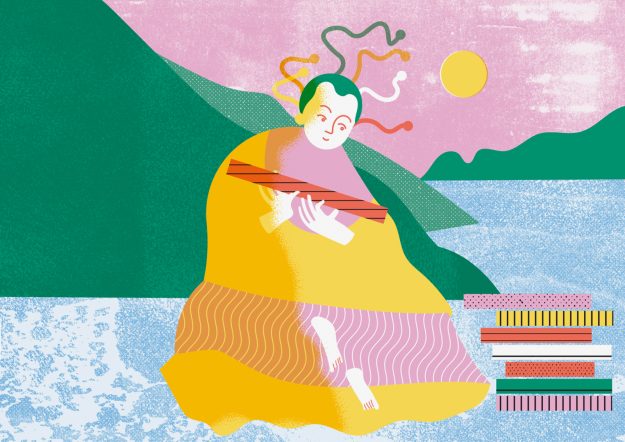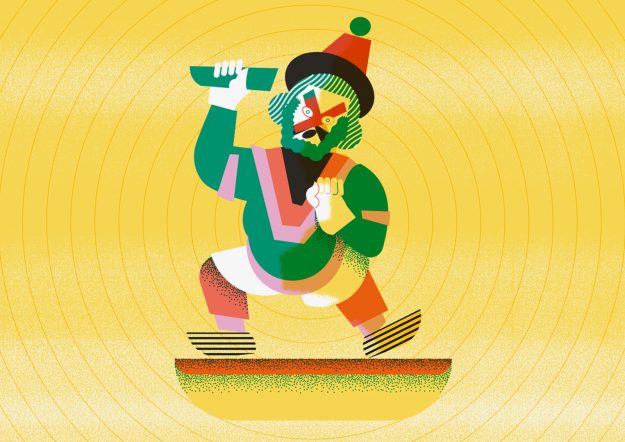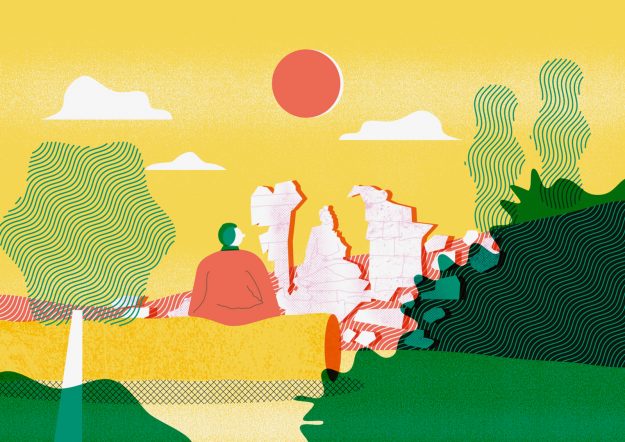A couple of years ago, scholar of Buddhism Donald Lopez was kind enough to give a talk to the Tricycle staff, and afterward, someone asked him what he thought were the most pressing topics in Buddhist studies. He answered in the form of four questions that scholars have yet to answer: When did the Buddha die? What are the origins of Mahayana Buddhism? What are the origins of Buddhist tantra? And why did Buddhism disappear in India? He didn’t have much time to elaborate, so we asked him when he could return. In January, Lopez discussed the subject further, this time at a talk attended by Tricycle’s staff and our readers. What follows has been adapted from his remarks.
—James Shaheen, Editor-in-Chief
Let me begin with a disclaimer: I will not be able to provide a definitive answer to any of these questions. I can only talk about the importance of raising them and how we might understand their terms.

Question 1: The Buddha’s Death
In India, the most important things that happened were: first, the life and teachings of the Buddha; second, the rise of the Mahayana—whatever we mean by that word; third, the rise of tantra; and fourth, the disappearance of Buddhism. When we look at Indian Buddhism, these raise four major questions that scholars have been struggling with for almost two hundred years. Let’s begin with the big one: When did the Buddha live?
We should begin with the Buddhist sources. In Chinese works, one of the most widely accepted dates for the death of the Buddha—and it’s important to note the interesting fact that we date Buddhism from the Buddha’s death, his passage into nirvana, not his birth—is 949 BCE. The Kalachakra Tantra gives the date as 876 BCE. The Theravada tradition gives the date as 544 BCE. Various Tibetan sources give dates as early as 2420 BCE. Contemporary scholars continue to argue for dates ranging from 544 to 368 BCE. That’s a gap of 118 years among modern scholars. When we look back at ancient history, we may think that a difference of 118 years is not that important. But that would be like not knowing whether the American Civil War began in 1861 or 1979. By contrast, scholars of Christianity have tried to get the birth of Jesus down to within about a year, perhaps 4 BCE. Setting the date has huge implications for what Buddhism was in the beginning, yet within this long range of time, we really don’t know with any precision when the Buddha lived.
We also have no Buddhist texts until some three or four hundred years after his death, depending on when he died. Again, when we look at Christianity, we have Paul’s First Epistle to the Thessalonians from about 50 CE, which is about twenty years after Jesus was crucified. So we’re looking at a huge period of time between the teacher and the teachings in the case of Buddhism.
Can we say that the Buddha was a historical figure at all?
Here, we always then turn to Ashoka, the great Buddhist king and the emperor of the Mauryan dynasty, whose rock edicts have the earliest mention of the Buddha and of Buddhist texts. We know from the location of these rock edicts that, by the time Ashoka was crowned in about 269 BCE, Buddhism was well established; the places where the Buddha was born, where he was enlightened, where he gave his first sermon, and where he passed into nirvana were already places of pilgrimage. It is fascinating that one of Ashoka’s edicts states that he restored the stupa of Kanakamuni, one of the earlier buddhas, so we know that by the time of Ashoka, the cult of the previous buddhas was in place, and that there was a stupa that Ashoka felt needed to be restored. We are then looking at Ashoka as a reliable marker in history; we can start talking about the Buddha and Buddhism with more precision.
We have two different Buddhist sources on how long after the Buddha Ashoka ruled. We have the famous Legend of Ashoka, the Ashoka Avadana in Sanskrit, which says that Ashoka was born 100 years after the death of the Buddha. Then we have the famous Pali text, the Dipavamsa, which says that Ashoka was crowned 218 years after the death of the Buddha. If we assume that Ashoka was crowned when he was around 20 years old, that’s a gap of about one hundred years.
The question of when the Buddha died remains unknown to us and very difficult to determine. Of course, this question raises another troubling question: Can we say with certainty that the Buddha was a historical figure at all? The evidence that we have is from Ashoka’s rock edicts from this later period. No one has found a tooth or a bone in a Buddhist stupa that can be identified as belonging to the Buddha. Recently, Professor Bernard Faure at Columbia University published a book in French called The Thousand and One Lives of the Buddha (the English translation will be out in August 2022), in which he argues that the case can be made that the Buddha was not a historical figure. But whatever the case may be, we’re still left with this huge problem of dating a tradition based on the death of a founder whose death we cannot date. That’s the first question.

Question 2: The Rise of Mahayana
The second question is about the rise of the Mahayana. Long after the passing of the Buddha, whenever that was, we see the appearance of texts called Mahayana sutras. We should not think of the Mahayana as a movement but rather as individual texts with their own devotees. One of the things essential to the rise of the Mahayana is writing. In ancient India, speech or voice was considered to be the medium of the truth. Priests from the brahmin caste would memorize and recite the sacred Vedas, which were preserved orally from father to son. We know also that Buddhism began as an oral tradition, and the memorization and recitation of sutras was a major part of the duties of Buddhist monks. Much of the repetition in the Pali suttas is seen as evidence of their oral origin.
Then at some point the sutras were written down. There is a reference to the texts being first written down in Sri Lanka in the last decades before the Common Era. In India, centuries after the death of the Buddha, whenever that was, we see texts being composed that begin “Thus did I hear. At one time, the Buddha was staying on Vulture Peak.” These are the works of later monks and nuns, and these texts contain some new doctrines.
It’s an overstatement to see a complete break between the earlier tradition and the Mahayana, but we do see, for example, the Buddha being exalted in ways that he had not been before. He becomes a more deified figure in some of these texts. The Lotus Sutra says that his lifespan is immeasurable and that he didn’t really pass into nirvana. The bodhisattva, originally a rare figure who vows to liberate all beings in the future rather than becoming an arhat, supplants the arhat as the ideal. Philosophically, impermanence is sometimes displaced by emptiness, and the idea of detachment is no longer discussed so much in terms of the foulness of the human body but in terms of everything being like an illusion. The whole idea of no-self is challenged with the notion of Buddha nature. And we see the presence of different buddhas—Amitabha being the most famous—each with their own Buddha field, their own pure land.
All of these new developments are part of “the Mahayana” that went on to travel from India to China, Japan, Korea, Tibet, and Southeast Asia. The introduction of writing provides portability, a way to make many copies of something. One of the things that is so interesting in Mahayana texts like the Lotus Sutra is that they talk about the great karmic benefit one receives from copying, disseminating, and preaching the scripture—benefits beyond that of building a stupa or other meritorious acts.
Because these texts call often themselves “Mahayana,” the “great vehicle,” and because they became so important across Asia, we tend to think that they won the day in India; they did not. The Mahayana was likely always a minority in India in the sense that it had to defend itself throughout its history there. So the works of many of the great Mahayana philosophers in India—from Nagarjuna to Atisha, over about a thousand years—include a defense of Mahayana sutras as the word of the Buddha, which means that there were many people who were arguing that they were not. But these texts were widely accepted elsewhere, and as a result the Mahayana has great fame today. Where those texts came from remains something of a mystery.

Question 3: The Origin of Buddhist Tantra
What are the origins of Buddhist tantra? What makes this question so hard to answer is that we have to first ask: What do we mean by tantra? This Sanskrit term, which means “handbook” or “manual,” appears in the names of many texts, not all of which use the term to describe what we call Buddhist tantra.
The rise of Buddhist tantra includes the rise of wrathful deities, sexual imagery, mantras, mandalas, and what we might even call magic. All of these things already existed in one form or another in Buddhism, but for reasons that we don’t understand, they begin to play a prominent role in Indian texts, both Hindu and Buddhist.
Eventually, these texts—which early on largely describe rites for things like defeating enemies, living a long life, or finding buried treasure—become theologized, providing the foundation for great traditions of theory and practice, especially in the yoga tantric traditions of Tibetan Buddhism and Shingon in Japan. But the dividing line between the Mahayana and tantra is hard to draw. People debate whether tantra is of “Hindu” or “Buddhist” origin.
With the rise of Buddhist tantra, we also see many figures who once appeared on the periphery of Buddhist sculpture and mandalas start moving from the edge to the center. Take the example of Vajrapani. Vajrapani appears in the Pali canon as a protector of the Buddha; he is often depicted as a bearded figure holding a club in the background of early Buddhist stone carvings. However, once we get into the tantras, he stops being simply a henchman or bodyguard and becomes the bodhisattva of power; some texts call him a buddha. We know that the Buddhists were often at odds with the followers of the Hindu god Shiva in India, and in these tantras these guardian deities are depicted beating and trampling Hindu deities. These guardian deities, these wrathful deities with garlands of human heads and carrying various weapons, are brought into the pantheon and are worshipped as defenders of the dharma. They’re bodhisattvas, they’re buddhas, and they are going to bring us to enlightenment faster.
This goal of enlightenment, however, seems to have been added later; the earlier texts are about how to gain magical powers. It’s clear that magic attracted patrons—Indian, Chinese, and Tibetan kings—to particular teachers. Stories about the arrival of Buddhism in a new country are typically not about a monk preaching the dharma in a village; they tend to be about a monk coming to the court with something that the king wants—medicine or, very often, magic. This is how Buddhism gets started there. People tend to not want to talk about the connection between Buddhism and magic, but it’s quite important and central to answering this question about Buddhist tantra.

Question 4: The Disappearance of Buddhism
The last question is, why did Buddhism disappear from India? There are two key words in that question. What do we mean by Buddhism, and what do we mean by disappear? We can say that by the time that the Portuguese explorer Vasco da Gama’s ship landed on the southern coast of India in 1498, Buddhism had disappeared from the subcontinent. But what does that really mean?
There are a number of Buddhist narratives about the disappearance of the dharma that are important to consider. But there is another strong narrative, which we must dispute: that Muslim invasions are responsible for the disappearance of Buddhism in India. There’s much to consider here.
The earliest scholars of Buddhism in Europe believed that Buddhism had disappeared from India and that it had been driven out by brahmin priests, by the Hindus. But then we read the travel accounts of the great Chinese pilgrims, most importantly Xuanzang, the Tang dynasty monk who was in India from 627 to 645. He travels widely, and he finds deserted monasteries again and again. Some monasteries are thriving, some are abandoned, there’s nobody there. They’re in ruins. When Buddhist monks stopped being wandering ascetics begging for their alms each morning and started establishing large monasteries, they could no longer be supported by the local populations. They needed to have royal patronage. Kings started giving land to monasteries and providing workers to plow the fields and grow the crops so the monks and nuns could have food. But if the king is overthrown, if his dynasty dies out, if he is replaced by a devout Hindu king, then that monastery will die because it has no source of sustenance.
What does it mean for Buddhism to be gone?
Remember that the Pali words that we translate as monk and nun, bhikkhu and bhikkhuni, literally mean “beggar.” Monks and nuns are prohibited from touching money, tilling the soil, and earning a living. They are completely reliant on the community. So if the trade route shifts north or south and there are no more merchants who are supporters of Buddhism coming through town, that monastery will eventually be abandoned. Thus, long before any Muslims arrived in India, Buddhism was declining in many regions while still thriving in others.
What, then, can we say about the Muslims? The Kalachakra Tantra, one of the most famous tantric texts, is an important resource for historians because we’re able to date it. We can determine that it was composed around 1025 of the Common Era, and we can probably place it in modern-day Pakistan. The Kalachakra Tantra describes an apocalyptic war in the distant future when the Buddhist army of Shambhala, which is somewhere in the Himalayas, will recapture India and defeat the mlecchas. Mleccha is a Sanskrit word usually translated as “barbarian.” But when we read the Kalachakra Tantra, it’s very clear that these are Muslims. Their teacher is Madhumati (Mohammed), they pray toward a city called Makha (Mecca), and they practice circumcision. So there’s no question that Buddhists in northern India in the early 11th century felt threatened by Muslims.
We also know that Nalanda monastery was sacked by Muslim troops around 1200. And we know, for a variety of reasons, that Buddhism in India must have already been in decline. But when this decline began and when it ended is hard to say.
What does it mean for Buddhism to be gone? Does it mean that there are no longer any big monasteries? One could say yes. If there are laypeople still worshipping images of the Buddha, say, near the border with Myanmar in the east, is Buddhism still there? One could also say yes. But as an institutional presence, it seems to have been gone by the time that the Europeans arrived in 1498. And it was probably largely because of the loss of patronage. Exactly what Buddhism is and what it means for it to disappear are big questions.
Students often ask me a different question. They ask me whether I think Buddhism is true. I tell them that I think there are at least two things in Buddhism that are factually accurate. One is that death is certain, and that the time of death is uncertain. The second is that everyone wants happiness and does not want suffering. I ask my students to think about those two statements and consider what follows from them.